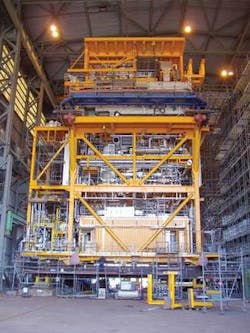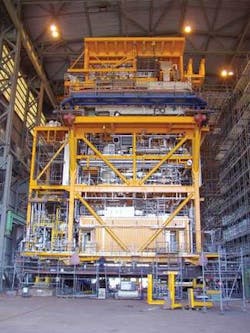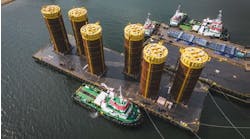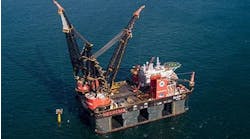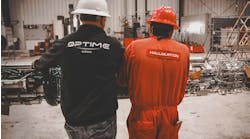Fabricator responds to North Sea compression/minimal platform demand
Energy supply fears in Britain are triggering an upsurge in gasfield development. Much of the development is in the southern North Sea, close to the UK/Netherlands median line.
In construction terms, the main beneficiaries are local specialists in small platforms such as HSM Steel Structures. The company’s yard in Schiedam recently shipped consignments for two separate projects, and capacity already is filling up thanks to new monopole platform orders from Shell.
The compression module for the Montrose A platform at HSM’s yard in Schiedam.
One of the completed deliveries was designed to increase throughput at CH4 Netherland’s Markham complex. This had been installed in 1992 by Lasmo, a UK independent later acquired by Eni.
When CH4 took over as the latest operator in 2003, the Markham J6A process platform was nearing the end of its useful life. Compression was needed both to sustain production on J6A and to tie in supplies from newly developed Chiswick and Grove fields in UK waters. However, the existing installation could not structurally withstand the extra weight of a new module.
Instead, CH4 opted for a new compression platform, awarded to HSM late last fall under a €25 million contract. According to HSM’s procurement manager, Edwin Prinse, the price was a little above the company’s estimate in the budget stages, derived from IV Oil & Gas’ FEED study. “But we were still the lowest in terms of price,” he points out.
This was an EPC contract, with a customary tight schedule for a southern gas basin platform, in this case nine months to sailaway. One of the main concerns for HSM had been materials availability - due to time constraints, it had been obliged to pre-order large quantities of steel pipes and fittings, with the risk that some of these might be superfluous. “The requirements varied from regular carbon steel to duplex and 6Mo,” Prinse adds, “which carries a typical lead time of six months.”
The new installation is a four-deck compression/riser platform which will link to the existing J6A facility in 37 m of water via a 5-m long bridge. Total weight of the new structure is 2,850 metric tons, comprising 1,200 tons for the topsides, 850 tons for the jacket, and 800 tons for the four piles. The most troublesome items in terms of delivery timing were the slugcatchers, and the free-issued Solar compressor and associated turbine. The compressor had to be shipped in from San Diego.
After load-out on multi-wheel trailers supplied by Mammoet, Seaway Heavy Lifting’sStanislav Yudin was due to complete the installations during August. At peak, the new platform will handle 2.6 MMcf/d from Grove and 2.7 MMcf/d from Chiswick. The latter will produce through a new unmanned platform (built by SLP in Lowestoft), which will export to J6A through an 18-km, 10-in. pipeline. Grove is being developed via redundant topsides from ExxonMobil’s Camelot field (recently decommissioned), which was refurbished by another Dutch yard. Gas will be sent through a 14-km, 10-in. line to Markham. Seaway again is managing the installations.
The two pipelines will have different wall thicknesses and will incorporate different materials, and the incoming gas will impact the riser connection interface on the new platform, says HSM’s marketing manager, Koos Krispijn. There also are different specifications to address on the UK and Dutch sides of the export routes, but this is more of an issue affecting the classification society, Lloyds.
Spare 12-in. risers and riser connections have also been installed on the new compression platform, allowing it to handle future supplies from two to three other fields in the area.
Wood compression
The other shipment due out of Schiedam, on August 1, was the 1,000-ton Wood and Gas Export (WaGE) compression/treatment module for Talisman Expro’s Montrose A platform. This, too, was an EPC contract, but with a 15-month delivery schedule.
Paladin, acquired last summer by Talisman, commissioned this job as part of a re-development of the Montrose/Arbroath complex, originally installed by Amoco. The dual purposes of the new module are to allow development of the high pressure oil and gas accumulation, Wood, via a 9.5-km subsea tieback; and to harness Montrose’s gas, most of which had been flared, for export to the UK via a new spur link to the CATS trunkline system. According to London-based field analysts Britboss, Wood should produce 15 MMcf/d during 2007.
This is HSM’s first experience working with Talisman, although the contract was placed by Paladin. “During the tender phase,” Krispijn says, “Paladin had not completed the detailed design, so it preferred a tender price based on the Rhicoms system. But because of our experience with these types of compression modules, we offered an alternative lump-sum price to reduce the level of risk, which Paladin accepted in February last year.”
The WaGE module, with dimensions of 19 x 14 x 27 m, features a MAN compressor. According to Krispijn, it is comparable to the Markham module, with coincidentally the same dimensions and weights, and the same 6Mo steel grade. Again, all front-end engineering was handled by IV Oil and Gas. Petrofac, the facilities management company running the platform, conducted preparatory strengthening work on the deck. Heerema will install the module.
Recently, HSM received a letter of intent from NAM/Shell to supply two new Trident monopile platforms per year over the next five years for various fields in the southern North Sea. The first four of these will be for NAM’s L9 A and B development, and Shell’s Shamrock and Caravelle fields in the UK sector.
HSM’s site covers 75,000 sq m, with a covered production area of 12,000 sq km. Facilities include one prefabrication shop and three assembly shops, with a 50-m wide quay capable of berthing all types of offshore barges. As a member of the RijnDijk group since 2004, it can call on the assistance of sister company Escher for process module skids, housing equipment for tasks such as gas dehydration or glycol regeneration.
